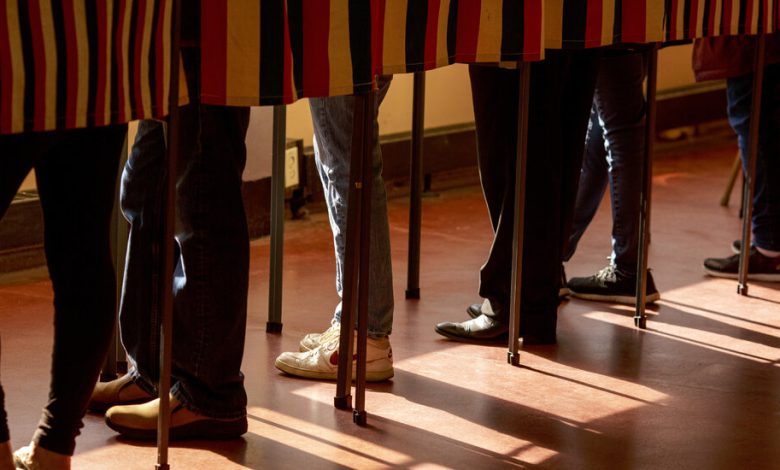Millennials and Gen Z Are Tilting Left and Staying There

As the saying goes, if you’re not a liberal when you’re young, then you have no heart, and if you’re not a conservative when you’re old, you have no brain.
The idea, of course, is that liberalism is a game for the youth and that age brings security, stability and a natural resistance to change. The upshot, in American politics, is that while most voters might start on the center-left, with Democrats, they’ll end their political journey on the center-right, with Republicans. One party represents disruption and change; the other party represents a steady hand and the status quo.
Or at least that’s the story. The reality is a little more complicated. Not only does our narrative of political change over time exaggerate the degree of rightward drift among different people as they age, but there’s good evidence that, for the youngest generations of Americans, it is hardly happening at all.
The evidence comes from a new Wall Street Journal analysis of the latest data from the General Social Survey, a comprehensive examination of American attitudes and beliefs, conducted since its creation in 1972 by the National Opinion Research Center at the University of Chicago.
It is true, according to these researchers, that voters typically become more conservative as they get older, which is to say, as they gain income, buy property and start families. But the extent of that drift — of where it finally reaches — depends on where they start. When the Pew Research Center studied this question in 2013, for example, it found that the cohort of baby boomers who turned 18 under Richard Nixon was much more Democratic than the later cohort of boomers who turned 18 under Jimmy Carter.
Overall, according to the General Social Survey, boomers, who came of age during the turmoil and transformation of the 1960s and 1970s, are still more liberal than not. Gen Xers, who came of age during the Reagan revolution, started off more conservative than their older counterparts and have become the most consistently conservative generation in the electorate.
The case of Millennial voters is where things start to get interesting. As children of 9/11, the War on Terror and the 2008 financial crisis, Millennials — born between 1981 and 1996 — entered the electorate much more Democratic than their immediate predecessors. But while they have gotten a little more conservative in the years since, it has been at a much slower rate than you’d expect.
What’s more, the gap in the number of Millennials who identify as Democrats rather than Republicans is huge, with more than twice as many self-identified Democrats as Republicans. The next cohort on the roster, Gen Z, is even more liberal and Democratic than Millennials, and shows no indication of becoming substantially more conservative as it ages.
Now, we should always be a little wary of talking about “generations” as uniform, monolithic or even particularly coherent. But groups of Americans do share common experiences, and it is not hard to explain the persistence of left-leaning beliefs and liberal self-identification among young Americans.
In addition to the events of the 2000s, there are those of the 2010s, specifically the slow and grinding recovery from the 2008 recession and the rise of a right-wing populist movement that continues to threaten the rights of many different people all over the country. The slow recovery, in particular, produced a broad dissatisfaction with life in the United States among many young people, energizing phenomena like Senator Bernie Sanders’s two campaigns for the Democratic presidential nomination and prompting many younger Americans to express their open dissatisfaction with capitalism as an economic system.
There’s something else to consider. For the last 15 years, neither the Republican Party nor political conservatism has stood for stability and a steady hand. Just the opposite: From the Tea Party onward, it has stood for chaos, disruption and instability.
A person who turned 18 in 2008 lived through, over the next decade, an economic crisis that erupted during a Republican presidential administration, a government shutdown instigated by Republican legislators and a Republican presidential administration that was, from beginning to end, defined by chaos and turmoil.
Now, as they enter the middle of their fourth decade, they are witness to a Republican-led Supreme Court that has ended the constitutional right to an abortion and a Republican congressional party that is so dysfunctional that it can’t even elect a speaker of the House, rendering Congress inert at a time when it needs to act.
Democrats are in comparatively better shape, but that’s not the same as good shape. There is a real disconnect between many younger Americans and the Democratic Party, on issues you might expect — like student loan debt — and issues you might not, like U.S. support for the Israeli government.
Millennials and Gen Zers may well age into more conservative views, but that doesn’t mean they’ll vote for Republicans. And if you want to understand the Republican Party’s growing hostility to free and fair elections — to the idea that the party should abide by the will of the majority — you should look no further than its extraordinarily poor standing with the two youngest groups of Americans.
When you’re no longer sure you can win on a level playing field, it’s harder to sustain any enthusiasm for democracy.
The Times is committed to publishing a diversity of letters to the editor. We’d like to hear what you think about this or any of our articles. Here are some tips. And here’s our email: [email protected].
Follow The New York Times Opinion section on Facebook, Twitter (@NYTopinion) and Instagram.
